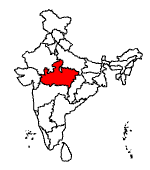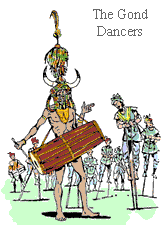
Dimdima
Online Children's Magazine from India

Dimdima
Online Children's Magazine from India
As its name suggests Madhya Pradesh is situated in the centre of India. It is the biggest state covering an area of 4,43,446 sq. km. Its tribal population is larger than that of any other state. Gonds, Bhils, Oraons, Korkens and Kols are the major tribes.
Area : 3,08,000 sq. km.
Population : 6,03,85,118.
Language : Hindi.
Capital : Bhopal is the capital.
Physiography :
The state occupies the Deccan plateau. The main river systems are the Chambal, the Betwa, the Narmada, the Tapti, the Mahanadi and the Indravati. The Narmada, one of the most sacred rivers of India, rises in the heart of the state and flows west. The Mahanadi flows eastward. The Chambal forms the northern border of the state with Rajasthan and UP. The ravines of Chambal are well known.
The Vindhyas and the Satpura are well known hill ranges.
Major Cities :
Major cities are Gwalior, Indore, Ujjain, Ratlam, Sagar, and Jabbalpur.
Flora & Fauna :
The state is well covered by forests. Teak, sal and bamboo are the most important commercial trees. The state is rich in wildlife. One can find, bison, black buck, deer, (chital and sambar) and wild buffalo besides many other smaller species of animals. Barasingha can be found only in Kanha National Park and white tigers in Shivpuri.
Crops :
Farming is the mainstay of the economy. Main food crops are jowar (sorghum), rice, wheat and some varieties of coarse millets.
Soya bean is produced on a large scale in many parts of the state today and the state can be considered as the largest producer of soya in the country.
Other commercial crops are cotton, sugarcane and some oil seeds like sesame.
Mineral Resources:
Madhya Pradesh is rich in natural resources like iron ore, manganese ore, coal, limestone and tin.
Madhya Pradesh saw a golden age during the Imperial Guptas (c. 300 – 400 A.D.). Then came the Huns. The Huns were defeated by emperor Harsha in the 7th century. Harsha was a patron of art and culture and was kind and generous to his subjects, giving away all the riches he had. We are told that he was once reduced to "begging a cloak for himself."
After Harsha, different parts of the state we now know as Madhya Pradesh were ruled by different dynasties — one of whom, the Chandellas, constructed the well-known series of temples at Khajuraho, between the 10th and the 11th centuries.
Akbar annexed the Malwa region of the state in the mid-1500's. Rani Durgavati who ruled over the Gond region courageously defended her territory against the Mughals but was eventually defeated.
Two other notable women rulers of Madhya Pradesh were Queen Ahilyabai Holkar of Indore and the Gond queen, Rani Kamala Devi.
Madhya Pradesh as we now know it, came into being on 1st November, 1956.
Madhya Pradesh abounds in monuments and places of pilgrimage.
Ujjain has been a pilgrim destination since ancient times, being one of India's most sacred cities. It was also a city of joy, learning and commerce for several centuries. Chandragupta II ruled from here as did many other kings after him.
The famous Kumbh Mela is held here every 12 years.
Bhopal, the capital, was founded by the legendary Raja Bhoja, in the 11th century.
Sanchi, northeast of Bhopal, is one of the world's most important centres of Buddhist art. The emperor Ashoka is said to have constructed eight stupas in Sanchi, three of which have survived.
Indore, situated in the heart of the Malwa plateau was the seat of the Holkars.
Mandu, had a very chequered history. The beautiful Rani Roopmati is still remembered by the poets of Malwa. The local people believe her lyrical voice can still be heard across the Narmada calling to her beloved, Baz Bahadur.
Gwalior came into prominence during India's first freedom struggle in 1857. It was near Gwalior that Tantia Tope was defeated and the Rani of Jhansi, killed during the final assault by the British.
The temples of Khajuraho are world famous.


Dimdima is the Sanskrit word for ‘drumbeat’. In olden days, victory in battle was heralded by the beat of drums or any important news to be conveyed to the people used to be accompanied with drumbeats.
Bharatiya Vidya Bhavan
K. M Munshi Marg,
Chowpatty, Mumbai - 400 007
email : editor@dimdima.com
Bharatiya Vidya Bhavan
505, Sane Guruji Marg,
Tardeo, Mumbai - 400 034
email : promo@dimdima.com
Dimdima.com, the Children's Website of Bharatiya Vidya Bhavan launched in 2000 and came out with a Printed version of Dimdima Magazine in 2004. At present the Printed Version have more than 35,000 subscribers from India and Abroad.